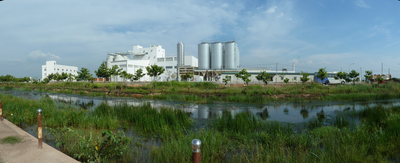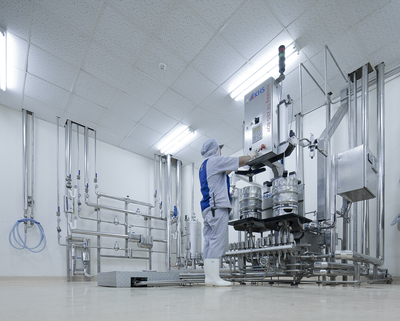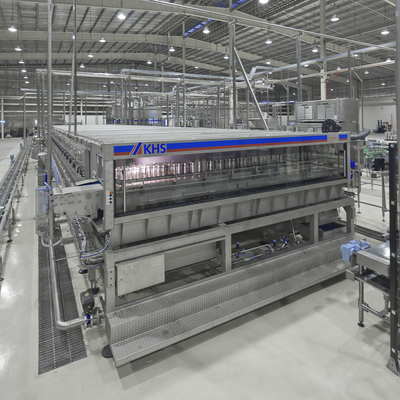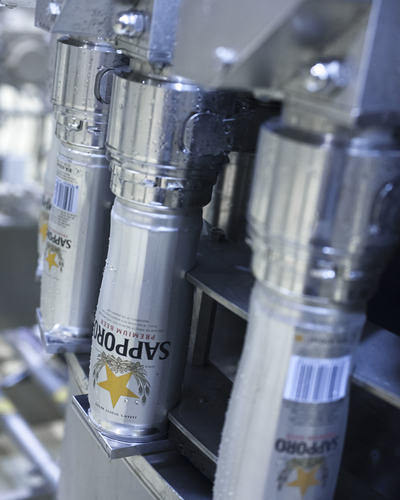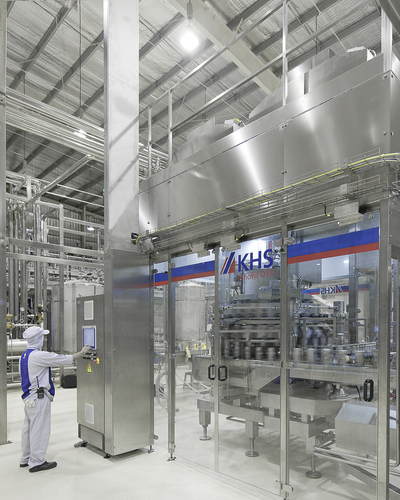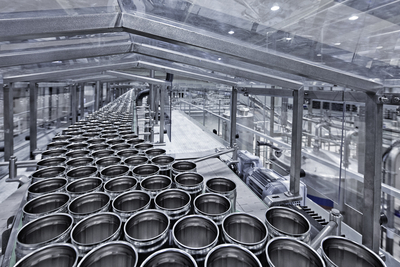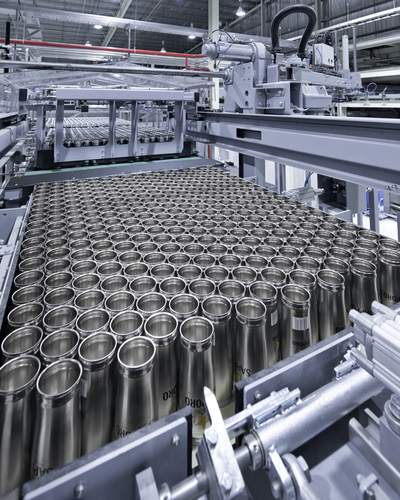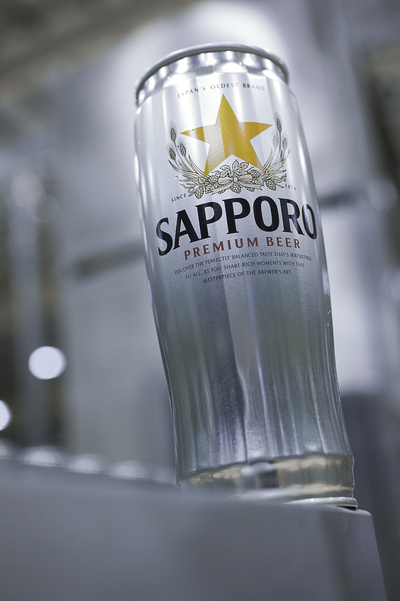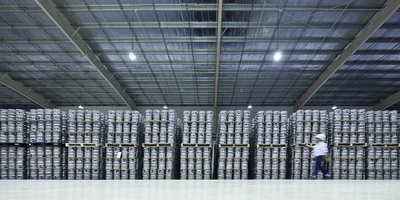
Opportunities exploited
Sapporo Group invests in Vietnam – in a new brewery with three KHS Turnkey lines
Werner Gessner* Tung Minh Tuan** Founded in 1876, Sapporo Breweries Ltd. is Japan's oldest brewery group. As Japan's fourth largest brewery group with a market share of 12%, Sapporo Breweries Ltd. today has five brewing plants in Japan. Sapporo Breweries Ltd. is embedded in Sapporo Holdings Ltd., whose field of activities includes five business areas: alcoholic beverages within Japan; alcoholic beverages internationally; soft drinks and foodstuffs; restaurants and real estate. With about 72%, Sapporo Holdings Ltd. continues to realize most of its sales with alcoholic beverages within Japan. Almost 9% are accounted for by the soft drinks and foodstuffs sector. Restaurants account for about 7% of sales. With approximately 6%, international activities involving alcoholic beverages lie roughly equal with the real estate sector. The latest steps taken by the Sapporo Group which could significantly change this percentage share in favor of "international activities involving alcoholic beverages" in the next few years include the founding of Sapporo Vietnam Ltd., a joint venture between the Sapporo Group and the Vietnamese-state-owned Vinataba (Vietnam National Tobacco Corporation) in 2009, and the erection of a brewery near Ho Chi Minh City in 2011. This brewery is the second Sapporo Brewery outside Japan. The first is the Sleeman Brewery in Canada. Since being taken over in 2006, the Sapporo Premium brand has been even more successful in Canada and the USA than before; it has had double-digit annual growth and is in Number One position amongst the Asiatic premium beer brands in North America. Hirofumi Kishi, General Director Sapporo Vietnam Ltd.: "As the first Japanese brewery group to operate its own brewery in Vietnam, we are hoping for considerable success for our Sapporo Premium brand in the Vietnamese market, not least because of our pioneering status. By investing exclusively in KHS technology in our brewery just outside the gates of Ho Chi Minh City, we are ensuring high quality for our Sapporo Premium beer in bottles, cans and kegs from the very beginning." * Manager Market Zone Asia Pacific, KHS GmbH, Bad Kreuznach, Phone 06 71-8 52-24 33 ** General Director, KHS Vietnam, Ho Chi Minh City, Phone +84-8-39 97 97 93 Vietnam – Asia's third-largest beer market with further potential In 2007, the Sapporo Group decided to become more deeply involved in the growth beer market of South East Asia. There were several reasons for focusing more and more on Vietnam and finally establishing Sapporo Vietnam Ltd. there in 2009. With an annual domestic beer consumption of approximately 25 million hectoliters and a per capita consumption of approximately 28 liters, Vietnam is already today Asia's third-largest beer market after China and Japan. Vietnam is also a market for which a high economic and population growth, and therefore an increasing beer consumption, is forecast for the future. Double-digit annual percentage growth rates when it comes to beer consumption seem to be entirely realistic. For 2012 alone, a percentage increase in beer sales in the high double-digit range is expected. The annual beer consumption in Vietnam is expected to reach almost 70 million hectoliters by 2025. "If beer consumption increases as forecast, by the end of the decade, Vietnam could be Asia's second-largest beer market and therefore be ahead of Japan," remarks Kishi. Approximately 90 million people with an average age of 28 years currently live in Vietnam. This means that the target group of young adults, and therefore the main target group for the Sapporo Premium brand, is particularly large in Vietnam. Another aspect in favor of the Sapporo Group's "Vietnam decision" is that beer prices are relatively good here. While the average price for 100 liters of beer in China is currently about 25 euros, in India it is 50 euros and in Vietnam about 60 euros. What is more, logistically Vietnam is well-placed as a starting point for exports to other South-East Asian countries. As an elongated coastal state, the country borders directly onto China, Laos, Cambodia and the South China Sea. According to Kishi, "In addition to all these advantages, there are no cultural barriers between Japan and Vietnam, and therefore nothing in the market stands in the way of growth for Sapporo Premium". Test market for Sapporo Premium brings positive results Sapporo Premium was tested on the Vietnamese market in 2010. "Above all, there were three things we wanted to find out", says Kishi. "First, whether the taste of Sapporo Premium was accepted in Vietnam, whether the packaging was right, and thirdly, whether sales partners were willing to include Sapporo Premium in their range." The result was that the taste of the beer was convincing. There were many positive comments from the sales partners. As far as the packaging was concerned, it was found that there was room for improvement with regard to the visual appearance of the 0.33-liter can. Instead of white/silver - as designed for the Canadian market - the 0.33-liter can for Vietnam is now available in gold/black. The background to this is that the Vietnamese love the color gold as they associate this with good quality and wealth. At the same time, the color black is perceived as elegant, and in Vietnam elegance is directly associated with wealth and quality. 10,000% increase envisaged in 2012 With such positive test market results, Kishi has no worries for the future of Sapporo Vietnam Ltd. While effort was primarily put into the erection and expansion of the new brewery building in 2011, the focus in 2012 will be on the setting up and development of a functioning sales network. "We are taking on 150 sales personnel whose task will initially be to establish our Premium beer brand in and around Ho Chi Minh City", says Kishi. "At the same time, we will be starting 2012 with advertising campaigns for Sapporo Premium - on TV as well as in other areas." The envisaged sales target for 2012 is an ambitious 100,000 hectoliters. In comparison, the sales figures for 2011 were just 1,000 hectoliters. From a percentage point of view, this means an envisaged increase of 10,000%. Sales figures of 1.5 million hectoliters envisaged for 2020 The targets for subsequent years are also ambitious. "We will continue to expand our sales area in Vietnam from 2013", explains Kishi. "By 2016, we can easily see Sapporo Premium becoming the most important Premium beer brand on the Vietnamese market after Heineken. We are fixing sales of Sapporo Premium for 2020 at 1.5 million hectoliters." A high envisaged growth, which in all probability will be positively affected by changing market conditions. This is because the percentage share of premium beers in the Vietnamese beer market currently still lies at 15%, but according to forecasts, it is expected to be 30% by 2020. As well as consistent quality and brand policy, another positive aspect regarding the realization of predicted growth rates is the population and economic growth. High-quality image of canned beer "We also foresee changes concerning the distribution of container types in the market", says Kishi. "In our estimation, cans in particular will become more and more popular on the Vietnamese market in years to come." The current situation is that about 70% of all beer sales in Vietnam are accounted for by glass bottles, and a further 30% by cans and kegs. Whereby, with a share of less than 1% of the containers used, the keg is still relatively unpopular. A helpful aspect as far as the additional growth of cans is concerned is the stylish image that this container enjoys on the Vietnamese market. Here, the consumption of canned beer effectively means "being able to afford something" and enjoying a Western lifestyle. This is also the reason why, in Vietnam, canned beer is also a perfect present on many different occasions. An interesting fact is that, with more than 20 canning lines, KHS currently has a share of approximately 90% of the canning line market. "With KHS, the technical solution is equally as convincing as the service quality", comments Kishi. Exclusive use of KHS quality In order to be equally well equipped to meet the expected demand for Sapporo Premium beer in cans, glass bottles and in kegs, Sapporo Vietnam has invested in as many as three KHS lines for the new brewery. These include a refillable glass line, the capacity of which is initially designed for filling 18,000 0.33-liter glass bottles/h. In a second expansion stage, the capacity of this line is to be increased to 30,000 0.33-liter glass bottles/h. The company has also invested in a canning line which fills 0.65-liter cans as well as 0.33-liter cans, and has a capacity of 13,000 and 18,000 cans/h respectively. The decision was also made to set up a keg filling line and therefore to install the Keg Boy C2 which processes up to 35 20-liter kegs/h. Two lines, one pasteurizer An interesting solution is that the canning and glass bottle line currently share an Innopas PISC pasteurizer. One reason is that, at the moment, production is carried out either with the bottling line or with the canning line. In the next expansion stage, a further Innopas PISC pasteurizer will be brought into use so that both lines can operate simultaneously. The establishment of automatic palletizing and depalletizing for the glass line and the integration of an automatic palletizer and a wrap-around packer into the canning line are also planned in a further expansion stage. "With KHS, conversion and expansion activities are planned in advance right down to the last detail", explains Kishi. "We were given excellent advice by KHS in this regard." Gentle depalletizing process In the canning line, cans are depalletized by the Innopal ASH. Here, the pallets are lifted in a three-sided enclosed well into the respective pushoff position. A pusher system enclosed on four sides controls the centering of every single layer during depalletizing, which is a prerequisite for the careful handling of sensitive can material. All the surfaces of the depalletizer that come into contact with the cans are covered with plastic sheeting and thus ensure that the product is handled extremely gently. The heart of the canning line: the electronically controlled Innofill DVD volumetric filler The heart of the canning line is the electronically controlled Innofill DVD volumetric filler which has 30 filling stations. Cans are fed to the filler after the inspection and rinsing process. In brief, the filling process is as follows. After they are purged with CO2, the cans are pressurized. The liquid valve then opens. Pneumatic cylinders control both the liquid valve and gas passages. The filling process takes place under pressure. Once filling is completed, the existing pressure is reduced to that of the surrounding atmosphere. Gas escapes through the snifting channel. Snifting is pressure-controlled with little foaming. A major benefit of the Innofill DVD is that the filler can be changed over to deal with varying cans of the same diameter at the press of a button The operator retrieves the values programmed into the system, and production simply continues with the new can size. This results in time savings and increased machine availability. A seamer seals the aluminum lids on the cans. Pasteurization with integral PU controller and sustainable operation Following level inspection, the cans pass through the single-deck Innopas PISC pasteurizer. This has an integral PU control system and is designed particularly for gentle product handling. No superheating, no high sprinkling temperatures - the careful handling of Sapporo Premium is the key factor here. Faultless in-circuit spraying results in particularly high process quality during pasteurization. KHS clamp nozzles provide an extremely precise spray pattern. Overlapping of the water sprays between the pasteurizer heating zones is thus largely avoided. The heat balance within the machine is optimized and the water consumption is considerably reduced. The energy and water consumption in continuous pasteurizer operation is reduced to a minimum by the heat exchange between the heating and recooling zones. "Ultimate product quality and sustainable operating methods are two particularly important aspects for us", says Kishi. "KHS equipment meets our high expectations in this regard in every respect." In the KHS canning line, further inspection and coding of the cans is carried out after the pasteurization process. Cans are then manually packed in cartons, which in turn are subjected to automatic sealing and coding. Palletizing is carried out manually. Innopack SP single-column modular packer as crater and decrater in the glass line Crates filled with returned refillable glass bottles are also depalletized manually. Glass bottles are removed from the crates by the Innopack SP single-column modular packer. A significant advantage of this single-column packer is the programmability of the packing cam and the resulting ability to optimize paths and cycle times. The Innopack SP can thus be adapted perfectly to suit every handling situation and ensures flexible operation. Double-end bottle washer for high hygiene expectations While crates are fed to the Innoclean KW crate washer, glass bottles pass to the Innoclean DM bottle washer. Sapporo Vietnam Ltd. specifically decided on the double-end version of the bottle washer. The reason for this was that, particularly in warmer regions - in Vietnam high temperatures can be expected at almost any time of year - a physical separation of dirty bottles and clean bottles is of great importance for hygiene. The contamination of returned bottles is usually considerably higher here than in temperate climatic zones. Extremely low-oxygen filling ensured for cans and glass bottles After the freshly cleaned glass bottles have been inspected, they are transported onwards to the heart of the refillable glass line: the Innofill DPG-ZMS filling system, which has 72 filling stations. The pneumatically controlled filling system impresses with its simple operation, low maintenance requirement and high system availability. If other types of glass bottle should be used for Sapporo Premium in the future along with the 0.33-liter glass bottle, the filling system can be quickly and easily converted for new bottle sizes thanks to quickly replaceable return gas tubes. The Innofill DPG-ZMS is distinguished by a particularly low-oxygen filling process, and ensures that the beer in the glass bottle is of high quality. A 12-way capper seals the bottles with crown corks. Both in the bottling and in the canning line, the KHS Innopro CIP system carries out internal cleaning of the filling machines at the end of production. "The low-oxygen filling process, which is provided in equal measure by the KHS can filler and the KHS bottling machine, is of the utmost importance to us", says Kishi. "This ultimately enables us to ensure that the consumer receives the first-class beer quality that we have promised." In the glass line, the bottles are labeled with cold-glue labels following level checking and cap inspection and pasteurization. Another Innopack SP single-column modular packer is provided for labeled and coded glass bottles which have passed inspection. This packs the glass bottles into freshly cleaned crates provided by the crate washer. The filled crates are palletized manually. Keg beer has market potential Although glass bottles and cans are the containers preferred by the Vietnamese consumer, Sapporo Vietnam Ltd. has also decided to offer Sapporo Premium in kegs. "In my opinion, there is still a lot of potential for kegs in Vietnam", explains Kishi. "One of the reasons for the low demand for keg beer is surely that only a few breweries stock this container. We intend to position ourselves as a pioneer with kegs in Vietnam." Innokeg Till Keg Boy C2 with DFC racking system In the new brewery, kegs are filled by an Innokeg Till Keg Boy C2. This is a semi-automatic keg washing and filling machine in which the washing and filling stations are installed on a common frame. Following the washing process, the kegs are pushed manually onto the racking station. Kegs are pressed against the appropriate treatment heads by pneumatic cylinders. The washing and racking program runs fully automatically. The first step in the process is the coupling of the keg to the washing station. The washing process starts by blowing out any residue with sterile air. This is followed by washing with hot water to remove coarse particles of dirt such as dried-on beer residue. Caustic solution is then introduced to the keg at a pressure between 3 and 3.5 bar. The kegs are washed by pulsating sprays. The final hot water rinse is followed by removing any remaining liquid and water with steam. This is firstly to ensure that the keg is sterile, and secondly to minimize the amount of oxygen in the keg and here too to allow filling with low-oxygen pickup. When washing is complete, the fitting always closes automatically when the keg is disconnected from the cleaning station. This maintains the sterile condition of the keg. Before the clean keg is connected to the filling head, the latter is specifically rinsed with hot water in order to ensure maximum microbiological safety. Condensate residues are completely blown out before the actual filling process takes place. This is followed by pressurization with CO2. Sapporo relies on the DFC system (Direct Flow Control) for the subsequent racking process. Here, the racking process is regulated by means of a control valve in the product infeed. Due to the slow filling phase and the subsequent fast filling phase, the contact area between the pressurizing gas and the beverage is specifically kept low. Maximum filling accuracy is achieved, as are great potential savings of pressurization gas and the exceptionally gentle-to-product treatment compared with the classical filling process. The filling speed is monitored at all times, and the oxygen and gas entering the product is minimized. Exact control of the filling quantity is achieved by means of volumetric monitoring using magnetic-inductive flow measurement. Multiple checks ensure perfect racking and perfect washing to an equal extent. All from one source - a KHS philosophy which also applies to the Innokeg Keg Boy C2. Here, the entire process equipment section is integrated within the system. All good things come in threes "In retrospect, the decision in favor of KHS Turnkey technology three times over was exactly the right one", says Kishi. "We are extremely satisfied with the performance of our KHS lines. Ultimately, the very good performance and reliability of the lines are a basic requirement for our planned ongoing success in the Vietnamese market." A planned ongoing success which is clearly apparent considering the intended expansion of the brewery's capacity. The production capacity is intended to be increased from the current 400,000 hectoliters/year to one million hectoliters/year by 2014 and to 1.5 million hectoliters/year by 2019. Sapporo philosophy smoothes the way to further success - in Vietnam as well as in the whole of South-East Asia A planned further success, which - and this according to Kishi is a most important point - is fully in line with the objective of the Sapporo Group: "Create value in food, and offer proposals for a rich and enjoyable life". "To ensure that our staff operate in line with the Sapporo philosophy from the very beginning, in the Vietnamese market we have not - as is often the case - taken over an existing brewery, but established a completely new brewing plant. Here, we have started with newly appointed staff who have been trained in the philosophy right from the beginning. A philosophy which is based on the very highest quality consciousness and with which it is also important that sales partners feel just as comfortable with the Sapporo Premium product as the consumers and staff. A philosophy, with the help of which the Sapporo Group would also like to convince other South-East Asian markets from their base in Vietnam of the benefits of Sapporo Premium more and more in the future. "It would be absolutely conceivable to build new breweries in other South-East Asian countries in future if the demand for Sapporo Premium were to increase", says Kishi. While taking full account of the Sapporo philosophy - a matter of course according to Kishi.
